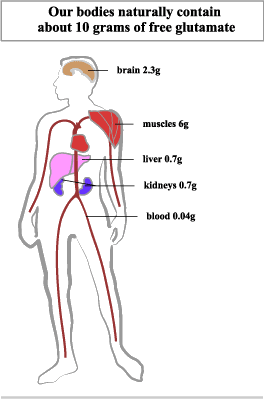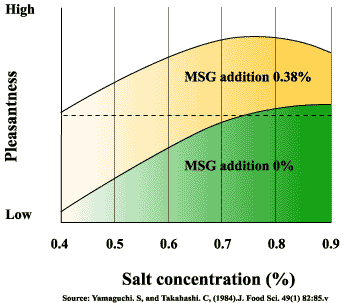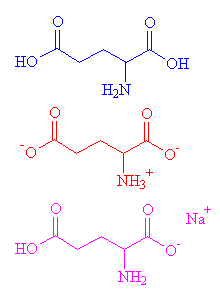Monosodium GlutamateThe molecule that enhances taste in food.
Also available: HTML only, VRML and JMol versions. Monosodium glutamate, or MSG, is a widely used flavor enhancer. It is said to add a 5th flavor to foods, a savoury taste, adding onto the four basic tastes (salt, sweet, sour and bitter). It has many names, ranging from accent and vetsin to ajinomoto. What is so curious about MSG is that it does not act by adding a specific taste of its own (as does salt or sugar), but instead it seems to serve as a stimulant which increases the sensitivity of taste receptors thus "multiplying" the taste of foods. MSG is the sodium salt of the amino acid glutamic acid. In aqueous solution, the acid reverts to its ionised form, and is known simply as glutamate. Glutamate plays a pivotal role in the biosynthesis of several key amino acids, and in fact, most of the non-essential amino acids (such as alanine and aspartine) derive their α-amino groups from glutamate. Glutamates are found naturally occuring in many fruits and vegetables, for example tomatoes, as well as many of the meats we consume (animal proteins contain between 11% and 22% of glutamic acid by weight).
|
MSG as a flavour enhancerAs meat ages, the proteins it contains decompose to form a number of other substances, among them MSG and a breakdown product of ATP called inosine monophosphate (IMF). These two compounds together have a very pronounced meaty flavour, and are the principal components responsible for the taste of meat. Different meats contain MSG and IMF in different amounts, and so have different flavours. For example, the ratio of beef has two times as much MSG as pork (but about the same amount of IMF). Since MSG is much cheaper and more readily available than IMF, it is often added by food manufacturers to bring out the flavour of meat. Surprisingly, mushrooms also contain a large number of proteins which are composed of glutamic acid. This might account for their slightly meaty flavour and the fact that mushrooms are usually served with meat dishes. |
 On average, a person consumes between 10 and 20 grams of bound glutamate, and approximately 1 gram of free glutamate daily. The only difference between them is that the bound glutamate comes in the form of a glutamate salt, for example monosodium glutamate, and the other does not. In addition, our body creates about 50 grams of free glutamate daily, and at any one time the human body naturally contains about 10 g of free glutamate.
On average, a person consumes between 10 and 20 grams of bound glutamate, and approximately 1 gram of free glutamate daily. The only difference between them is that the bound glutamate comes in the form of a glutamate salt, for example monosodium glutamate, and the other does not. In addition, our body creates about 50 grams of free glutamate daily, and at any one time the human body naturally contains about 10 g of free glutamate.
The controversy...
Research has shown that the body uses glutamates as nerve impulse transmitters in the brain, and that every major human organ contains glutamate receptors. They are also linked to memory retrieval. The main worry with glutamates however is that they are absorbed at a very fast rate into blood by the alimentary canal. This can lead to glutamate levels in the blood rising very quickly in a short period of time, and some scientists worry that this may cause irreversable damage to some parts of the human brain, due to overstimulation. It has been shown that high blood glutamate levels have caused neurotoxicity in rodents, however there is a firm debate over whether it has the same effect on humans.
MSG is now produced by the large-scale fermentation of starch and is found in many household foods. Most snack foods and canned foods will usually contain some concentration of MSG. It is also closely linked to Chinese restaurants, and it was once thought that these employed large amounts of MSG in their cooking. The link was so strong that the "symptoms" of MSG consumption were referred to as "chinese restaurant symdrome". Whilst it may have once had a bad reputation and was considered as a potentially dangerous chemical, this incorrect perception of MSG no longer exists, as research tests have obtained results to show otherwise, leading to chinese restaurants taking down their MSG-free food signs.
 Large amounts of scientific experiments have been aimed at finding out whether or not MSG is a dangerous chemical, but there has been no significant finding stating that it has harmful effects. However, there are several minor symptoms thought to be associated with MSG, the most common being headaches, nausea and drowsiness. These symptoms are always mild and rarely require medical attention.
Large amounts of scientific experiments have been aimed at finding out whether or not MSG is a dangerous chemical, but there has been no significant finding stating that it has harmful effects. However, there are several minor symptoms thought to be associated with MSG, the most common being headaches, nausea and drowsiness. These symptoms are always mild and rarely require medical attention.
In actual fact, MSG is more of a solution than a problem. Using MSG, it is possible to greatly reduce sodium levels in foods (40% less when table salt is replaced with MSG) while at the same time still enjoying the taste. The graph on the right shows that with a small addition of MSG, the pleasantness of a food can be greatly increased. The study evaluated people's responses to different versions of a clear soup, with and without MSG and with different levels of salt. The horizontal line shows the threshold level below which the participants found the soup to be unpalatable. Without the addition of MSG, the soup did not become palatable until the salt concentration reached 0.75%. With MSG, however, the soup was palatable with a salt concentration of only 0.4%.
MSG has also been used medically to treat hepatic coma (a condition of severe liver dysfunction which is accompanied by unresponsiveness).
Chemical Properties of MSG and Glutamates
- IUPAC name: sodium (2S)-2-amino-5-hydroxy-5-oxo-pentanoate
- Molecular Formula: C5H8NNaO4
- Molecular Mass: 169
- EU food additive code: E621
- It is a white powder with a melting temperature of 225°C and is very soluble in water.
References:
- http://www.foodstandards.gov.au/_srcfiles/MSG%20Technical%20Report.pdf
- http://www.chemicalland21.com/lifescience/foco/MONOSODIUM%20GLUTAMATE.htm
- http://www.glutamate.org/
- Wikipedia
![]()

